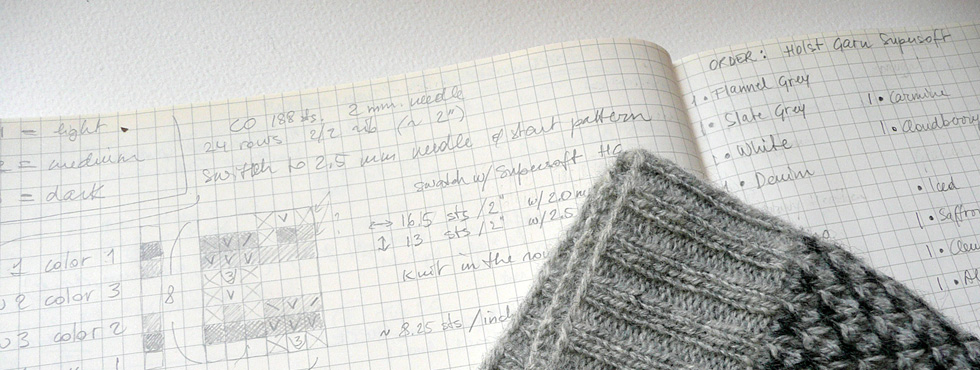PIP, as in Pattern In Progress. Have I told you how much I appreciate your help? I do. Since I posted about needing testers a few days ago, I got a few volunteers that between correcting mistakes and suggesting improvements are helping me shape up the pattern for Fragile Heart and teaching me things that will help me in future projects as well. But the most important thing I learned so far is:

I need reminders, lest I get ahead of myself.
You would not believe the stupid things I’ve done, and I thought I was in better shape this time. Told myself this was going to be easier; hey, it’s my second pattern, right? Eh. Well, it is easier, just not simple. The chart seems error-free, though I need to tweak the color values to make it print clearly in B&W as well as in color. Not so the written instructions. Charting the stitch motif was, er, challenging. No wonder the original stitch in Barbara Walker’s
book came only in written form. I had to chart that stitch before I could even try to modify it to get what I wanted. It took a lot of trial and error and in the end I used the chart so many times that I worked out all mistakes (fingers entwined). Then I worked backward from the chart to compile the written instructions, and I knit from those only once since the first test came out correct. I suppose what happened is what always happens when you try to edit your own writing: your brain knows what’s supposed to be there and compensates. There were not one, but two errors, and that was just one section of the pattern. A typo here, an omission there, the wrong explanation for ssk in the legend… This stitch is not for the faint of heart. It demands attention, even without errors, and I am amazed that none of my valiant testers has sent pointy objects my way, yet. One thing I particularly struggle with is the flow of information. Do I keep all the techniques together, all the charts together, all the written instructions together, or do I insert relevant bits and pieces where they are most useful? After reading many threads on Ravelry from the point of view of both designers and knitters, and after trying many variations on the theme in these first two patterns, I believe that there is no perfect system, one that will work well for everybody, unless I write a pattern for knitters who favor charts and one for those who prefer written instructions. Oh wait, and then one for those who print their pattern and one for those who transfer the PDF to their Kindle or iPad. What to do? 1) Condense and trim as much as possible. Make the complex easy to understand without writing a dissertation; reduce redundancy while keeping information available when needed; encode as much as possible on one page while following basic typography principles for readability… 2) Find a balance between the convenience of the chart knitter and that of the text reader. 3) Keep information that needs to be printed together, to reduce the number of pages a knitter needs to print. This works also for the knitter that reads on a digital reader, reducing the need to flip pages. Better go do what I just wrote down. Not that I presume to know how to write a pattern after a whopping
1.5 patterns under my belt. It’s just that by sharing my difficulties I hope to generate some discussion. Who knows? You may have tricks I haven’t thought of. I know it helped me to read Bethany’s thoughts on charts. What’s in the metal containers on my blackboard, you ask? You mean my finger puppets?

You never know when you are going to need a finger puppet.









